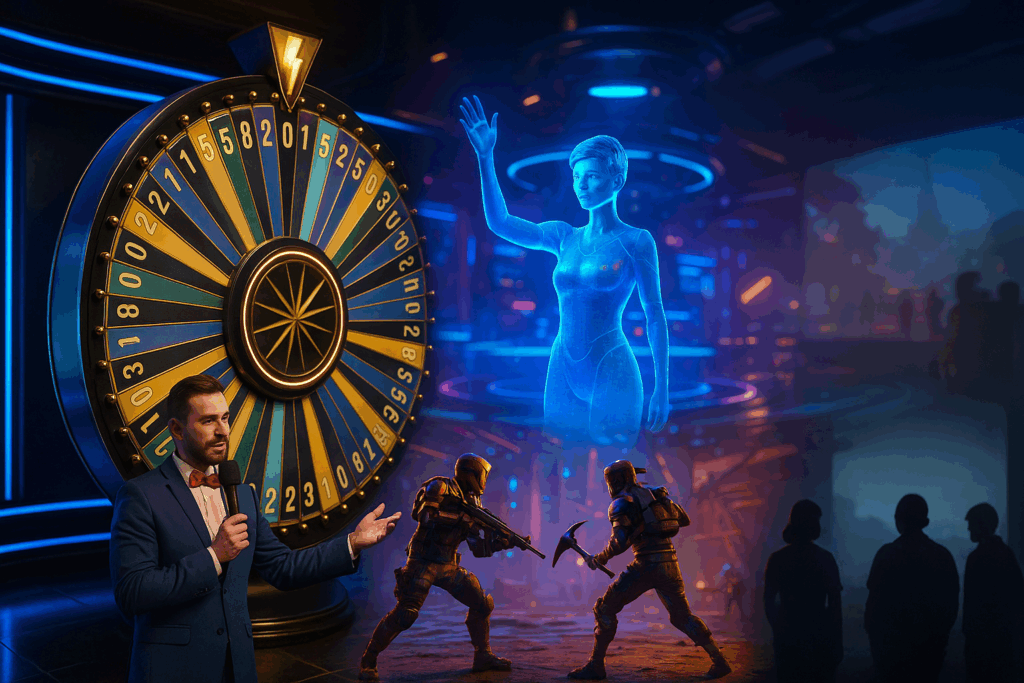The border between player and performer is fading fast. Modern games don’t just react to commands – they respond, observe, and sometimes even play back. The result is a hybrid experience where participation turns into entertainment. From casino streams to massive live events, interaction itself becomes the show.
Live play as entertainment
Streaming changed gaming culture. Once players started sharing their sessions, developers began to design for visibility. Twitch and YouTube Gaming turned private play into public performance. Now every gesture, win, or fail can be part of the spectacle.
In live casino formats, this happens in real time. The studio setup resembles a television show: hosts, lights, and sound effects. But the twist lies in interactivity. Each bet or vote affects what viewers see next. The chat, presenter, and random generator merge into one dynamic system.
Experience of Lightning Storm – where the show meets statistics
A clear example is the Lightning Storm project by Evolution Gaming. It merges game-show pacing with transparent mechanics. On the Lightning Storm casino result & history page, users can track previous rounds, multipliers, and verified outcomes. The goal is not to predict wins but to let players understand how the system behaves.
This transparency adds confidence to live casino formats. Visitors can explore session data, learn the logic behind bonus rounds up to 50x, and see how certified dealers maintain fairness. The platform functions as both an information hub and a learning tool about safe gaming. It’s part analytics, part entertainment, part stage.
When shooters turn into shows
Outside casino gaming, shooters and survival titles also transform play into spectacle. Fortnite leads the trend. Its live events – from the Travis Scott concert to the in-game “black hole” shutdown – gather tens of millions of participants. These aren’t marketing stunts but synchronized performances where the world changes before everyone’s eyes.
Other games experiment with similar ideas:
- Call of Duty: Warzone hosted limited-time story missions shown as live world events.
- Apex Legends introduced interactive tournaments with map transformations during matches.
- PUBG Mobile ran collaborations with K-pop and anime, turning classic battle royales into themed festivals.
- Twitch Plays Pokémon let viewers collectively control the game’s character through chat commands – pure chaos turned into history.
Each example shows a version of shared authorship. Players influence pacing, reveal narrative twists, or trigger effects visible to millions.

Social formats and live tension
Games like Among Us Live Sessions or Phasmophobia rely on voice chat, role play, and audience feedback. When streamed, they become a kind of reality show. Viewers don’t just watch; they root for, tease, and shape behavior. The tension of being watched changes decisions. Jokes land differently. Mistakes feel theatrical.
Even cooperative horror titles like Dead by Daylight build around observation. The killer knows he’s performing; survivors act like cast members in a slasher film. The show only works because everyone knows they’re being seen.
Elements that make a game perform back
Developers build around moments that spark emotional reactions rather than just stats. Visibility becomes part of design. Below are common spectacle mechanics across genres:
| Game Type | Core Spectacle Element | Viewer Role | Example Titles |
| Live Casino | Presenter reaction, random multipliers | Chat interaction, bets | Lightning Storm, Crazy Time |
| Shooter Event | Real-time world changes, live concerts | Collective experience | Fortnite, Apex Legends |
| Social Deduction | Player drama, voice chat tension | Voting, commentary | Among Us, Goose Goose Duck |
| Horror Co-op | Jump-scare timing, player panic | Emotional mirroring | Phasmophobia, Dead by Daylight |
These shared traits keep players invested longer. Every match or stream offers fresh content – not because the code changes, but because human reactions do.
Why visibility wins
Developers track not only playtime but also share rates, clip views, and chat messages. Games that “play back” create viral moments. They thrive on unpredictability, emotion, and collaboration.
For players, this design style means:
- Constant novelty. Each session feels unique, built on real-time reactions.
- Social presence. The sense of being part of a crowd adds excitement and pressure.
- Immediate reward. Feedback loops – cheers, memes, shoutouts – reinforce engagement.
- Personalization. Every outcome carries the player’s footprint; every audience has its interpretation.
This emotional cycle explains why interactive games dominate streaming platforms. Visibility multiplies value: what one person plays, thousands experience.
Between data and emotion
The success of this model lies in balance. Transparency and education, as seen in Lightning Storm’s open statistics, create trust. Emotional staging in shooters and social games keeps attention high. Together they define modern interaction: not one-way control, but conversation.
Whether you’re joining a global Fortnite finale, escaping ghosts in Phasmophobia, or studying multipliers on Lightning Storm, one thing stays true – the game now plays with you too.


